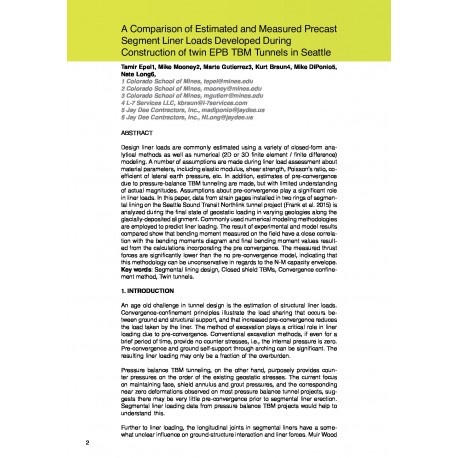Cart
0
0
No document
0,00 €
Total
Document successfully added to your shopping cart
Quantity
Total
There are 0 items in your cart.
There is 1 item in your cart.
Total documents
Total shipping
To be determined
Total
Search & filter
Search for a publication
Search & filter

A Comparison of Estimated and Measured Precast Segment Liner Loads Developed During Construction of twin EPB TBM Tunnels in Seattle
1064_a_comparison_of_estimated_a
M. Mooney / T. Epel / M. Gutierrez / K. Braun / M. Diponio / N. Long
Design liner loads are commonly estimated using a variety of closed-form analytical methods as well as numerical (2D or 3D fnite element / fnite difference) modeling. A number of assumptions are made during liner load assessment about
material parameters, including elastic modulus, shear strength, Poisson’s ratio, coeffcient of lateral earth pressure, etc. In addition, estimates of pre-convergence due to pressure-balance TBM tunneling are made, but with limited understanding of actual magnitudes. Assumptions about pre-convergence play a signifcant rôle in liner loads. In this paper, data from strain gages installed in two rings of segmental lining on the Seattle Sound Transit Northlink tunnel project (Frank et al. 2015) is analyzed during the fnal state of geostatic loading in varying geologies along the
glacially-deposited alignment. Commonly used numerical modeling methodologies are employed to predict liner loading. The result of experimental and model results compared show that bending moment measured on the feld have a close correlation with the bending moments diagram and fnal bending moment values resulted from the calculations incorporating the pre convergence. The measured thrust forces are signifcantly lower than the no pre-convergence model, indicating that this methodology can be unconservative in regards to the N-M capacity envelope.


